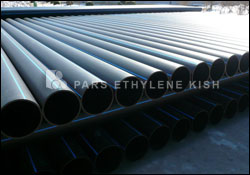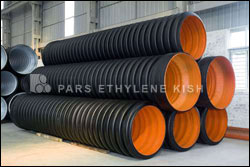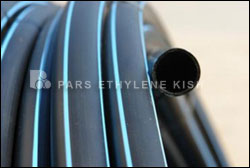
Features of HDPE Pipe
Piping made from polyethylene is a cost effective solution for a broad range of piping problems in municipal, industrial, marine, mining, landfill, duct and agricultural applications. It has been tested and proven effective for above ground, surface, buried, sliplined, floating, and sub-sur face marine applications. 
High-density polyethylene pipe (HDPE) can carry potable water, wastewater, slurries, chemicals, hazardeous wastes, and compressed gases. In fact, polyethylene pipe has a long and distinguished history of service to the gas, oil, mining and other industries. It has the lowest repair frequency per mile of pipe per year compared with all other pressure pipe materials used for urban gas distribution. Polyethylene is strong, extremely tough and very durable. Whether you’re looking for long service, trouble-free installation, flexibility, resistance to chemicals or a myriad of other features, high-density polyethylene pipe will meet all your requirements.
Consider the following features of HDPE pipe :
• LEAK FREE
Polyethylene pipe is normally joined by heat fusion. Butt, socket, sidewall fusion and electrofusion create a joint that is as strong as the pipe itself, and is virtually leak free. This unique joining method produces significant cost reductions compared to other materials.
• CORROSION, ABRASION, AND CHEMICAL RESISTANT

Polyethylene piping’s performance in mining, dredging and similar applications proves it will outwear many more costly piping materials when conveying a variety of abrasive slurries. HDPE has excellent corrosion resistance and is virtually inert. It does not need expensive maintenance or cathodic protection. It offers better overall resistance to corrosive acids, bases and salts than most piping materials. In addition, polyethylene is unaffected by bacteria, fungi and the most “aggressive” naturally occurring soils. It has good resistance to many organic substances, such as solvents and fuels.
• EXCELLENT FLOW CHARACTERISTICS
Because polyethylene is smoother than steel, cast iron, ductile iron, or concrete, a smaller HDPE Pipe can carry an equivalent volumetric flow rate at the same pressure. It has less drag and a lower tendency for turbulence at high flow. Its superior chemical resistance and “non-stick” surface combine to almost eliminate scaling and pitting and preserve the excellent hydraulic characteristics throughout the pipe service life.
• LIGHTWEIGHT AND FLEXIBLE
Polyethylene pipe is produced in straight lengths or in coils. Made from materials about one-eighth the density of steel, it is lightweight and does not require the use of heavy lifting equipment for installation. It reduces the need for fittings, is excellent in shifting soils and performs well in earthquake-prone areas. HDPE resists. the effects of freezing and allows bending without the need for an excessive number of fittings. Since HDPE is not a brittle material, it can be installed with bends over uneven terrain easily in continuous lengths without additional welds or couplings.

• DUCTILITY AND TOUGHNESS
Polyethylene pipe and fittings are inherently tough, resilient and resistant to damage caused by external loads, vibrations, and from pressure surges such as water hammer. Even in cold weather polyethylene pipe is tolerant to handling and bending.
• MANUFACTURED UNDER AWWA, NSF, ASTM, AGA, EPA, DNR, DOT, API, FM, CSA AND OTHER NATIONALLY RECOGNIZED STANDARDS.
Polyethylene pipe is listed and approved by the standards or committees of the agencies listed above.
• AVAILABLE IN DIAMETERS FROM
½ INCH TO 63 INCH. Polyethylene pipe is available in a wide range of diameters and wall thickness, with flanges, elbows, tees, wyes, and valves, providing a total system solution. HDPE pipe is also available in Iron Pipe Size (IPS), Ductile Pipe Size (DIPS) as well as metric sizes. Plastic Pipe Institute members can provide pipe, fittings and other appurtenances.
• APWA COLOR CODING BYAPPLICATION
Polyethylene pipe is available with color coding by application as developed by the utility location and coordination council of the American Public Works Association (APWA).